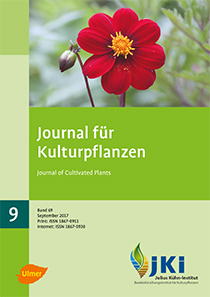Detection and growth of endophytic entomopathogenic fungi in dicot crop plants
DOI:
https://doi.org/10.5073/JfK.2017.09.02Keywords:
Endophytes, Brassica napus, Vicia faba, entomopathogenic fungi, phytopathogenic fungi, immunofluorescence microscopyAbstract
The presence and distribution of fungal endophytes in plants is commonly assessed by re-isolation on agar media or detection by PCR-techniques. Histological studies on the process of colonization of the host plant have only scarcely been performed. In the present study, the development of entomopathogenic fungi on the plant surface and inside the tissue was examined by light and fluorescence microscopy of leaf samples treated with various dyes or, to guarantee the specificity of injected endophytes, with primary polyclonal and secondary FITC-conjugated antibodies; diaminobenzidine-tetrahydrochloride (DAB) was applied as stress test for the detection of hydrogen peroxide. Four species of entomopathogenic fungi were studied and compared with three phytopathogenic fungal species. The host plants were oilseed rape (Brassica napus), faba bean (Vicia faba), and cucumber (Cucumis sativus).
When blastospores of selected four fungal species were infiltrated into B. napus leaves they appeared to germinate only on the leaf surface, but not within the mesophyll. Successful re-isolation from B. napus inoculated with B. bassiana, Isaria fumosorosea or Metarhizium anisopliae showed that these entomopathogens were able to persist in the tissue for at least two weeks. Formation of brown precipitates after leaf treatment with DAB in the presence of B. bassiana indicated the production of hydrogen peroxide by B. napus but not by V. faba. Overall, the results indicate a lower endophytic colonization than could have been expected from the literature, suggesting nutrient availability in the plant intercellular space and absence of cell wall and cell membrane degrading fungal enzymes as fungal growth-limiting factors. It is concluded that data on endophytic colonization should generally be supported by histological evidence of the kind and amount of fungal growth in the host tissue.
Published
Issue
Section
License
The content of the journal is licensed under the Creative Commons Attribution 4.0 License. Any user is free to share and adapt (remix, transform, build upon) the content as long as the original publication is attributed (authors, title, year, journal, issue, pages).
The copyright of the published work remains with the authors. The authors grant the Journal of Cultivated Plants, the Julius Kühn-Institut and the OpenAgrar repository the non-exclusive right to distribute and exploit the work.







